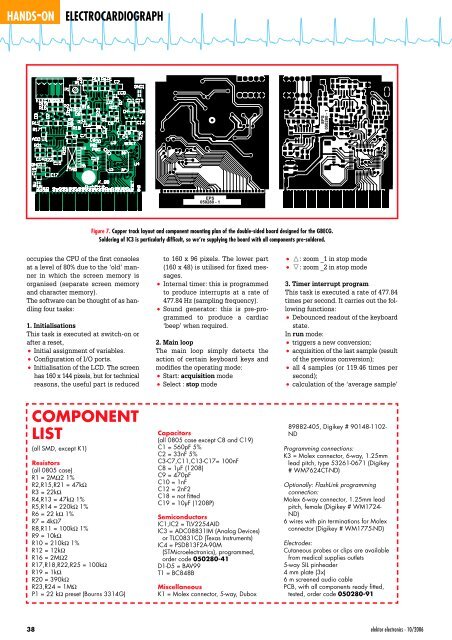FREE DVD
FREE DVD
FREE DVD
Create successful ePaper yourself
Turn your PDF publications into a flip-book with our unique Google optimized e-Paper software.
HANDS-ON<br />
ELECTROCARDIOGRAPH<br />
EPS<br />
050280 - 1<br />
EPS<br />
050280 - 1<br />
EPS<br />
050280 - 1<br />
Figure 7. Copper track layout and component mounting plan of the double-sided board designed for the GBECG.<br />
Soldering of IC3 is particularly difficult, so we’re supplying the board with all components pre-soldered.<br />
occupies the CPU of the first consoles<br />
at a level of 80% due to the ‘old’ manner<br />
in which the screen memory is<br />
organised (separate screen memory<br />
and character memory).<br />
The software can be thought of as handling<br />
four tasks:<br />
1. Initialisations<br />
This task is executed at switch-on or<br />
after a reset,<br />
• Initial assignment of variables.<br />
• Configuration of I/O ports.<br />
• Initialisation of the LCD. The screen<br />
has 160 x 144 pixels, but for technical<br />
reasons, the useful part is reduced<br />
to 160 x 96 pixels. The lower part<br />
(160 x 48) is utilised for fixed messages.<br />
• Internal timer: this is programmed<br />
to produce interrupts at a rate of<br />
477.84 Hz (sampling frequency).<br />
• Sound generator: this is pre-programmed<br />
to produce a cardiac<br />
‘beep’ when required.<br />
2. Main loop<br />
The main loop simply detects the<br />
action of certain keyboard keys and<br />
modifies the operating mode:<br />
• Start: acquisition mode<br />
• Select : stop mode<br />
• : zoom _1 in stop mode<br />
• : zoom _2 in stop mode<br />
3. Timer interrupt program<br />
This task is executed a rate of 477.84<br />
times per second. It carries out the following<br />
functions:<br />
• Debounced readout of the keyboard<br />
state.<br />
In run mode:<br />
• triggers a new conversion;<br />
• acquisition of the last sample (result<br />
of the previous conversion);<br />
• all 4 samples (or 119.46 times per<br />
second);<br />
• calculation of the ‘average sample’<br />
COMPONENT<br />
LIST<br />
(all SMD, except K1)<br />
Resistors<br />
(all 0805 case)<br />
R1 = 2MΩ2 1%<br />
R2,R15,R21 = 47kΩ<br />
R3 = 22kΩ<br />
R4,R13 = 47kΩ 1%<br />
R5,R14 = 220kΩ 1%<br />
R6 = 22 kΩ 1%<br />
R7 = 4kΩ7<br />
R8,R11 = 100kΩ 1%<br />
R9 = 10kΩ<br />
R10 = 210kΩ 1%<br />
R12 = 12kΩ<br />
R16 = 2MΩ2<br />
R17,R18,R22,R25 = 100kΩ<br />
R19 = 1kΩ<br />
R20 = 390kΩ<br />
R23,R24 = 1MΩ<br />
P1 = 22 kΩ preset (Bourns 3314G)<br />
Capacitors<br />
(all 0805 case except C8 and C19)<br />
C1 = 560pF 5%<br />
C2 = 33nF 5%<br />
C3-C7,C11,C13-C17= 100nF<br />
C8 = 1µF (1208)<br />
C9 = 470pF<br />
C10 = 1nF<br />
C12 = 2nF2<br />
C18 = not fitted<br />
C19 = 10µF (1208P)<br />
Semiconductors<br />
IC1,IC2 = TLV2254AID<br />
IC3 = ADC08831IM (Analog Devices)<br />
or TLC0831CD (Texas Instruments)<br />
IC4 = PSD813F2A-90M<br />
(STMicroelectronics), programmed,<br />
order code 050280-41<br />
D1-D5 = BAV99<br />
T1 = BC848B<br />
Miscellaneous<br />
K1 = Molex connector, 5-way, Dubox<br />
89882-405, Digikey # 90148-1102-<br />
ND<br />
Programming connections:<br />
K3 = Molex connector, 6-way, 1.25mm<br />
lead pitch, type 53261-0671 (Digikey<br />
# WM7624CT-ND)<br />
Optionally: FlashLink programming<br />
connection:<br />
Molex 6-way connector, 1.25mm lead<br />
pitch, female (Digikey # WM1724-<br />
ND)<br />
6wires with pin terminations for Molex<br />
connector (Digikey # WM1775-ND)<br />
Electrodes:<br />
Cutaneous probes or clips are available<br />
from medical supplies outlets<br />
5-way SIL pinheader<br />
4 mm plate (3x)<br />
6m screened audio cable<br />
PCB, with all components ready fitted,<br />
tested, order code 050280-91<br />
38<br />
elektor electronics - 10/2006

















